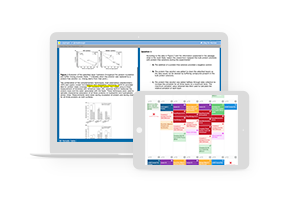
An unavoidable part of any solid MCAT study plan is MCAT full-lengths. They help you build endurance to withstand a 7.5-hour exam and are the best way to test your content knowledge and understanding.
Though the number of full-length MCAT exams you should take will vary from person to person, be prepared to at least complete all the official AAMC practice tests. It’s also wise to pepper in additional MCAT practice exams into your study schedule.
MCAT full-lengths offer you a wealth of knowledge and information on your test-taking habits if you know how to review practice tests correctly.
Table of Contents
- Reviewing MCAT Full-lengths
- A Caveat About Statistical Analysis
- Tools for Reviewing Practice MCAT Full-lengths
- Reviewing in Stages
Reviewing MCAT Full-lengths
Reviewing MCAT practice exams has many benefits:
- It provides insights into the sources of past mistakes.
- It can uncover information that you completely missed your first time through a passage.
- It can help you understand the structure of the MCAT far better than you might while only taking full-lengths for the sake of building endurance.
However, reviewing also poses significant challenges.
During the review process, you are constantly pitted against your own internal biases, whether it is hindsight telling you that you totally knew that, confirmation bias telling you that this new mistake is exactly the same as the previous one, or overgeneralization wanting to draw overarching conclusions from small, chance trends.
As a result, extracting valuable lessons from MCAT full-length reviews depends on the strategies you use. If you’re a Blueprint student, you’re in luck; Blueprint’s MCAT practice exam analytics do most of the work for you!
A Caveat About Statistical Analysis
While tracking why you got a particular question wrong provides useful insights, don’t make premature (or any) plans for future behavior on the basis of information discovered this way.
Meaning, that if you were to discover you commonly change right answers to wrong ones, this doesn’t necessarily mean that you should suddenly decide to stick to your answers in the future. The reasoning for not doing so is two-fold:
- Tracking down the root cause of the error and uncertainty will yield much greater, more generalizable skills that are less prone to failure than simply establishing a correlation.
- The correlations you do find are very, very likely to be spurious due to the limited number of questions per exam, topic, section, and type. Simply switching from right to wrong answers five times across 59 questions may represent any type of error. The difficult questions in your next practice test may be on a topic you’re weaker on, and your tendency, in that case, may be to make wrong-to-right switches instead.
Sign up to get expert tips and exclusive invites to free MCAT classes and medical school admissions workshops!
Tools for Reviewing Practice MCAT Full-lengths
Here are some tools and exercises to help you improve your MCAT practice exam review.
Explain It to Your Imaginary (Or Real) Friend
The tendency when reading explanations, even when synthesizing information back onto paper, is to be somewhat passive in the process.
To avoid this tendency, try to not imitate the correct explanations for problems you are reviewing or for passages you’re dissecting in-depth. Instead, rewrite them as if you were explaining the concept to someone else. Bonus points if that someone else happens to be a non-premed.
You don’t necessarily have to put all this in writing. As long as you go through the process of actively synthesizing an explanation, making as few mental leaps, and taking as few shortcuts as possible, you will be surprised how well you start understanding and retaining concepts!
Lessons Learned Journal
This is where you will take notes, flag any questions, and write down your learnings from your reviews. Some students tend to create their own wrong answer spreadsheet, but we’ve built a Lessons Learned Journal directly into our platform to save you time and energy during your review. We’ve even recruited Blue, our AI MCAT tutor, to help create entries for you. Try it yourself by creating a free Blueprint MCAT account and taking a free practice MCAT exam.
MCAT Flashcards
When you extract particular pieces of obscure content knowledge or discover a set of facts that tends to slip your mind, making a set of Anki cards to refresh your memory in the future can be extremely helpful.
If you haven’t started a regular flashcard routine, sign up to get a free deck of 1600+ MCAT flashcards curated by Blueprint MCAT experts.
Reviewing in Stages
The truth is, you’re strapped for time. You won’t always have an empty hours-long block of time to dedicate to reviewing your MCAT full-lengths. It wouldn’t make sense to have every review session be the most exhaustive possible.
Instead, try breaking it up and approach a review in stages.
1. Light Review – Wrong Answers
Reviewing your wrong answers is the most obvious first step. There is nothing wrong with doing this, and we strongly recommend doing so as shortly after your practice exam.
At this stage, write down what type of error you made (knowledge, reasoning, reading comprehension, attention to detail, etc). Try to put special emphasis on writing an explanation in your own words before moving on from any single problem.
For each question, we recommend entering in your review sheet/Lessons Learned Journal both the proximal cause (what exactly went wrong? Knowledge, reading comprehension, attention to detail?) and the root cause (what caused the proximal cause – were you short on time, uncertain, overconfident?).
Remember, the purpose of entering these things is to build awareness, not to ultimately create just a single prescription to adjust your strategy.
2. Light Review – Flagged Answers
Reviewing flagged answers works fundamentally the same as reviewing wrong answers.
While you may have ended up with the right answer, you weren’t certain. Next time you might not be so lucky. Flagging indicates that you could still benefit from reviewing. Either enter these on your spreadsheet for wrong answers or start a second sheet.
3. Moderate Review – Problem Passages
Students are often tempted to stop at the ‘Light Review’ phase, as questions that weren’t missed or information that doesn’t pertain directly to any question may seem less relevant.
However, all information within an AAMC full-length is relevant for the real MCAT, whether it ever occurs in a question or not. Make a habit of reviewing passages entirely.
Since this consumes a fairly large amount of time, review first those passages where you either got one or more answers wrong or passages you simply didn’t feel comfortable reading.
4. In-Depth Reviews
To do an in-depth review, we want to categorize what we are looking at first. In general, an MCAT passage will have one of three possible formats:
- Informational: This passage type most resembles a textbook, a review article, or generally a summary of many years of research on a particular subject.
- Primary Research: These are passages of adapted research, with some identifying information (such as the names of proteins) removed, simplified laboratory procedures, and a small subsection of the original research forming the focus of the passage.
- Lab Manual: This type of passage reiterates key steps in an experimental procedure while omitting a large number of minutiae. It usually asks you to understand concepts underlying the procedure, underlying assumptions, and possible limitations of the experimental method being used.
To maximize the yield of your review, try to write down what type of passage you are looking at as you review it and narrow down the topic under discussion. For example, instead of just writing “Biochemistry,” the passage may be dealing with “Michaelis-Menten Kinetics.”
Once you’ve established categories, summarize the entire passage. Pay special attention to elaborating on any and all figures and graphs found within the passage (or provided in question stems), and include those in your passage breakdown template.
The purpose of a passage breakdown is to force you to pay close attention to every single sentence and every single diagram – a practice that is normally overlooked because we want to naturally find what is important at the time.
Working through this more thorough process will greatly improve your intuition in the future for what is or may be relevant and what is most likely not, as well as boost your ability to retain detailed information presented in a complex passage.
5. In-Depth Review – Breaking Down All Passages
As a final step, consider repeating the passage review process for all passages.
You may notice that during an extensive passage review, there is a strong tendency to uncover new information or gain clarification on previously murky concepts. This tendency may continue through passages you wouldn’t initially have considered troublesome.
Keep in mind that all AAMC full-length passages are chosen with some degree of deliberation and reflect the design goals of the people who will create the exam you take on test day too.
A lot of valuable information can be uncovered by paying close attention to AAMC passages!
6. In-Depth Review – CARS Review
CARS review functions slightly differently because you’re placing greater emphasis on understanding the passage holistically.
Use an approach similar to the in-depth passage review process. However, the number of arguments presented, the degree to which background information is provided, and the exact format of the piece may be somewhat more fluid than in science passages.
In general, CARS pieces do tend to be argumentative. Thus, it is helpful to make a list of key points:
- What are the main arguments presented within?
- Is the author’s point of view explicit or implicit? (Is tone used to establish a perspective, or are explicit statements used)
- Are arguments by other people mentioned and contrasted? If so, what are they, and by whom? Make a list of all names and their viewpoints.
- What evidence is presented within the text? (Evidence in this context need not be good evidence, simply presented directly within the text)
- How would you personally respond to this passage? (Do you agree, disagree, or think this isn’t a subject worth spending words on at all?)
- If you had to write 2 CARS questions of your own about this passage, what would they be?
Reviewing your MCAT full-length exams is critical to understanding concepts and truly mastering the MCAT. That’s why we implemented powerful analytics in our MCAT full-length practice exams, online MCAT course, and Live Online Course.
Here’s to prepping smarter, not harder!
Search the Blog

Free Consultation
Interested in our Online MCAT Course, One-on-One MCAT Tutoring or Med admissions packages? Set up a free consultation with one of our experienced Senior Student Advisors.
Schedule NowPopular Posts
-
MCAT Blog What's on the MCAT?
-
MCAT Blog How to Review MCAT Full Lengths

Free MCAT Practice Account
Need great MCAT practice?Get the most representative MCAT practice possible when you sign up for our free MCAT Account, which includes a half-length diagnostic exam and one of our full-length MCAT practice exams.
Learn More







